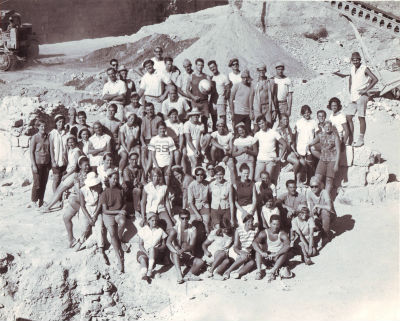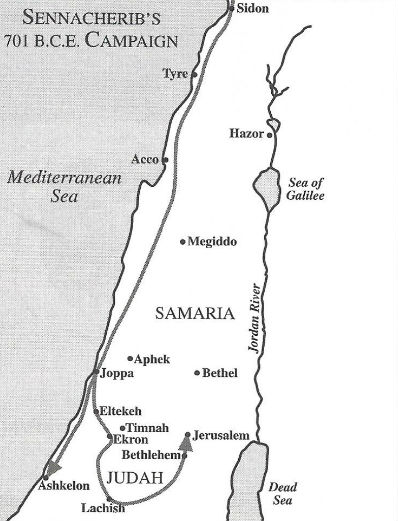Jerusalem Delivered: Isaiah, Hezekiah and God’s Intervention
By Neil Earle
 In Our Hands: Surrounded by enemies and on the brink of war, one nation stood alone and changed history.
In Our Hands: Surrounded by enemies and on the brink of war, one nation stood alone and changed history.On Tuesday May 23 my wife, Susan and I went to a screening of the documentary film “In Our Hands” about the Israeli capture of Jerusalem during the Six Day War of 1967.
We were not out to make a political statement – actually the capture of so much territory by the state of Israel, glorious as it was militarily, put them in a more precarious position in some ways. What were they to do with the newly conquered people who already resented the Jewish state – grant them independence or expand into their territories?
The Israelis themselves were split over this and the issue still bedevils the Middle East today.
But after 1967, in the year 1968, Israeli archaeologists started digging on the newly captured Temple Mount west of the Dome of the Rock. Then, in 1969 and 1970 Ambassador College partnered with Hebrew University to expedite the “Big Dig” as it as called. Susan and I and 70 classmates were there in 1970 and it was the most spectacular summer of our lives, the place we met and fell in love.
Really!
 Ambassador Diggers, Temple Mount 1970 and we were there! Neil, top left back row arms folded, Susan second row sixth from left next to girl in sunglasses. Click photo to enlarge.
Ambassador Diggers, Temple Mount 1970 and we were there! Neil, top left back row arms folded, Susan second row sixth from left next to girl in sunglasses. Click photo to enlarge.As dramatic as the Jewish capture of Old Jerusalem was in 1967, it reminds me this time around even more of another deliverance of Jerusalem, this time back in the 700s B.C.E. The days of Isaiah and King Hezekiah saw a heavily armed Assyrian fighting force invade the Holy Land to stamp out a rebellion against their imperial sway. It is one of the grand faith stories of the Bible and also one verified by at least two pieces of indirect archaeological evidence, as we shall see.
Let’s set the scene.
In the 700s BCE Jerusalem was King David’s City, the capital of ancient Judah. Sometime around 745 B.C., as the Assyrian Empire began to dominate the smaller nations of the Middle East, Isaiah was called to the prophetic office (Isaiah 6:1-3).
The Assyrian Thunderbolt
Isaiah’s appointment came in the nick of time. The Assyrian Empire based in Nineveh near modern-day Mosul were beginning a renewed period of expansion. Historians know this period well. Assyria was near the height of its power. “By that time the Assyrians held most of Mesopotamia, Syria, the Palestine coast, and Egypt. They enforced their rule by a deliberate policy of frightfulness, enslaving and torturing and killing thousands of captives” write Strayer, Gatze, and Harbison, in The Course of Civilization: Volume One, p. 30.
 Assyrian relief depicting a city under seige: Courtesy Columbia University, Department of Art History and Archaeology.
Assyrian relief depicting a city under seige: Courtesy Columbia University, Department of Art History and Archaeology.Isaiah’s thrilling call to prophesy (see Chapter 6) was the thrilling overture to this tale of ancient power politics. While the smaller nations and rulers wheeled and dealed to seek the favor of Assyria, Isaiah continually reminded them of the Great God before whom they were all just a drop in a bucket (Isaiah 40:15). He proclaimed repentance to all these nations – “in repentance and rest is your salvation, in quietness and trust is your strength” (Isaiah 30:15). Isaiah’s name said it all – it meant “Yawheh is salvation.”
Yahweh was the God of Judah and the brother nation Israel to the north whose ten tribes and their capital cities had split off from Jerusalem some years earlier (I Kings 12). But God still had his eye on them (Isaiah 28). Isaiah had a word for fierce Assyria too far away in their seemingly impregnable capital of Nineveh (Isaiah 10:5). A prophet named Jonah had been sent to them some years before and the Assyrians had heeded (Jonah 1-3).
So, though Isaiah was based in Jerusalem, his call to repentance and hope would remind all who would hear that the God of Israel ruled in the affairs of men. This generous Deity stood ready to forgive (Isaiah 1:16-20). He would surely intervene for any people if they would turn to him in real repentance and faith (Isaiah 2:5).
Hezekiah: A Legacy in Stone
With the Assyrians on the march King Hezekiah had fortified 46 cities – all of which fell to the Assyrian army (2 Kings 18:13). Hemmed up in Jerusalem it became necessary to secure the city’s water supply which was the Gihon Spring just outside the city walls. To prepare for the siege Hezekiah built a pool inside the city connected to the water supply by a long tunnel (2 Kings 20:20).“Hezekiah’s Tunnel” is still there – 1749 feet long and in places 100 feet beneath the streets of the city. It was discovered in 1880 and many like my wife Susan have walked through it as a “must do” tourist event in Jerusalem.
Carved into the walls of the tunnel about 20 feet from the ending at the Siloam Pool (mentioned in John 9:7) there is an inscription that reads: “While the stonecutters were still wielding the axe, each man towards his fellow…they heard the sound of each calling to his fellow…And on the days of the breakthrough, the stonecutters struck each man towards his fellows, axe against axe, and the water flowed form the source to the pool for 1200 cubits” (Shanks, Ancient Israel, page 182).
Some 1200 stamps found on jar handles in and around Jerusalem have been found bearing the inscription “lmk” meaning “belonging to the king.” The king’s own personal seal with a scarab for decoration has also come to light reading “Belonging to Hezekiah, son of Ahaz, king of Judah.”
Hezekiah was clearly a busy man but his faith inspires us today.
Isaiah went on to give shining visions of future hope that would far transcend his own day, visions of a Messiah who would appear to lead his people to lasting hope and security (Isaiah 11:1-5), of a time when nations would beat their swords into ploughshares, when lions would dwell with lambs. But he was no impractical mystic offering platitudes while the world about him fell apart. His offer of national repentance was meant to deliver small powers and superpowers alike. In describing the greatness of Israel’s God, Isaiah left behind a riveting and dynamic book full of the glory of God set to pen and ink (Isaiah 12:1-6).
“The Assyrians are Coming”
Isaiah’s ministry thus coincided with “the most momentous event [of] almost any period of Israelite history” said Lasor, Hubbard and Bush in their Old Testament History, p. 279.
By 740 Assyria’s Tiglath-pileser had expanded into northern Syria. Israel’s king in Samaria was forced to pay tribute (2 Kings 15:19). Soon, relentless Assyrian columns would slice across the upper Jordan region, seize Galilee and Gilead (Isaiah 9:1), and carry off many northern Israelites into captivity.
“The Assyrians are coming!” This alarm congealed the hearts of people in the Ancient Near East. Nations trembled (Isaiah 5:26-28). Nineveh’s warlords employed calculated terror! One Assyrian leader boasted: “I stormed the mountain peaks and took them….The heads of their warriors I cut off, and I formed them into a pillar over against their city…I flayed all the chief men who had revolted” (Finegan, Light From the Ancient Past, pp. 202-3).
This was the terrorist army that threatened Samaria and Jerusalem. But Isaiah the Prophet was as relentless as the armies of Nineveh. He preached deliverance and hope. He knew that cruel Assyria was no match for the God of Israel.
In a daring prediction, the Judaean seer forecast the end of Assyria while the empire was at its peak: “When the Lord has finished all his work against Mount Zion and Jerusalem, he will say, ‘I will punish the king of Assyria for the willful pride of his heart and the haughty look of his eyes’” (Isaiah 10:12).
The Spreading Shadow
But before the humbling of Nineveh, Isaiah’s God had a bone to pick with the corrupt, idolatrous Israelites north of Jerusalem in their capital of Samaria. God had singled out Israel to be an example of his way of fairness and equity. They, however, chose the slippery game of power politics and greedy commercialism with little regard for basic decency and compassion (Amos 2:6-8). Isaiah’s predecessors had noted how the Samarians had trampled on basic principles of social justice (Amos 6:1-7).
Inspired, Isaiah sang a “protest song” against Samaria’s moral and spiritual degeneration. His Ode to a Vineyard in chapter 5 got to the heart of the matter: “When I looked for good grapes, why did it yield only bad (verse 4)?”
 Hezekiah's tunnel: Anticipating an attack by Sennacherib of Assyria, the Judahite king Hezekiah (727-607 BCE) built a 1,749-foot-long tunnel to bring the water of the Gihon Spring within the city walls of Jerusalem. This successful building project (with its fresh supply of water, Jerusalem managed to withstand the Assyrian seige) is referred to in 2 Kings 20:20 and 2 Chronicles 32:4.
Hezekiah's tunnel: Anticipating an attack by Sennacherib of Assyria, the Judahite king Hezekiah (727-607 BCE) built a 1,749-foot-long tunnel to bring the water of the Gihon Spring within the city walls of Jerusalem. This successful building project (with its fresh supply of water, Jerusalem managed to withstand the Assyrian seige) is referred to in 2 Kings 20:20 and 2 Chronicles 32:4.The Doom of Samaria
“Now I will tell you what I am going to do to my vineyard,” God said. “I will take away its hedge, and it will be destroyed; I will break down its wall, and it will be trampled” (Isaiah 5:5).
That happened.
Samaria refused to heed the warning message, even when Jerusalem’s good King Hezekiah invited them to participate in ceremonies of national repentance. “People of Israel return to the Lord,” was the message (2 Kings 30:6). Samaria scorned it (verse 10).
Judgment fell. History records how Assyrian King Shalmaneser V (727-722) and then Sargon II (722-705) swept into Israel on their way to trounce the Egyptians. Samaria was destroyed and leveled, her people uprooted (2 Kings 17). “Israel’s proud kingdom had fallen, no more to rise” (Old Testament Survey, p. 211).
By the dreadful arithmetic of international politics it was one city down; one more to go.

Jerusalem Spared!
No. Not quite.
But it was oh so close. Isaiah and King Hezekiah watched as the Assyrians under Sennacherib had reached the very walls of Jerusalem (2 Kings 18, 19). Jerusalem stood encircled like a Judahite Alamo (Isaiah 1:7-9). But Judah’s king Hezekiah (716-687), had learned from Samaria's fall. He turned to the God of Isaiah and prayed a prayer of repentance for him and his people: “It is true, O Lord, that the Assyrian kings have laid waste these nations and their lands…Now, O lord our God deliver us from his hand, so that all kingdoms on earth may know that you alone, O Lord, are God” (2 Kings 19:17-19).
There is the lesson of all the prophets – God rules in the affairs of men.
Reassured by Isaiah (Isaiah 37:21-29), Hezekiah refused to be cowed by the taunts of Sennacherib’s army. He turned to God in repentance and faith.
The results were momentous. Secular history hints at a setback during Sennacherib’s last campaign. A piece of archaeology called the Taylor Prism in the British Museum records Sennacherib’s boast of shutting up Hezekiah in Jerusalem “like a bird in a cage.” But…it contains no record of the fall of Jerusalem. To many scholars this is evidence that Sennacherib faced an embarrassing setback outside Jerusalem (Finegan, Light From the Ancient Past, p. 213).
The Messianic Hope
Now, Isaiah’s tale of three cities is more than a quaint historical survey. Isaiah’s predictions pointed beyond his time. As the Assyrian darkness encircled Judah, the prophet offered a more far-reaching hope. Out of the conquered land of Galilee there would one day come a great Light (Isaiah 9:1-2). From the royal line of King David, represented by righteous King Hezekiah, would come an even mightier Deliverer (Isaiah 11:1-10).
Assyrian Postscript
Isaiah’s God is no respecter of persons and the prophet had a specific message of hope for the Assyrians as well. Isaiah 20:25 records the prophecy of both Egypt and Assyria becoming God’s people along with Israel. The Coptic Church in Egypt are Christians much in the news today. Thus many believe Isaiah 20:25 to be fulfilled in the New Testament period when the kingdoms in the region of Old Assyria became among the first to receive the Gospel. See Philip Jenkins intriguing The Lost History of Christianity.To this day there is an Assyrian Christian presence in the Middle East and even more so in North America. The leader of the Assyrian Church resides in Chicago and their descendants serve Israel’s Messiah to this day. Surely this is the Lord’s doing and remarkable in our eyes.
Christians see these prophecies fulfilled in the ministry of Jesus of Nazareth, the prophet from Galilee. Isaiah set forth a man born of a virgin as the ultimate Deliverer of his people (Isaiah 7:13-17). Jesus revealed himself throughout his ministry as the ultimate fulfillment of the hopes of his people Israel (Matthew 23:37)
But Jesus, like Isaiah, also warned of judgement for people and nations who will not turn to God in repentance and faith. “Unless you repent,” Jesus preached, “you too will all perish” (Luke 13:5). Big nations and small nations. Superpowers and individuals. Judgement then and judgement now. God does not change. This makes Isaiah’s tale of three cities a powerful message for today’s superpowers and ambitious would-be fomentors of hate and brutality. Terrorists will be avenged. Isaiah’s God decreed doom for Assyria and its capital, Nineveh: “Woe to the Assyrian, the rod of my anger, in whose hand is the club of my wrath! …The Lord, the Lord Almighty, will send wasting disease upon his sturdy warriors; under his pomp a fire will be kindled like a blazing flame” (Isaiah 10:5, 16).
That happened. Avenging armies from Babylon and Media finally closed the ring on proud Nineveh. In 612 B.C. the city was burnt, as Isaiah had foretold. The Assyrians had not learned the lesson from the preaching to them of Jonah – that instruments of judgement can themselves be judged, that God rules in the affairs of men and that he expects justice and fair play from those he has given worldly authority.
Those are lessons not just for Isaiah’s time but for all time (Isaiah 46:8-10). God is still on his throne and the God of Isaiah, the God who sent Jesus, stands ready to bless us if we change but to unleash judgement if we forsake his ways. God wants us to chose wisely and for his people to pray for that outcome.